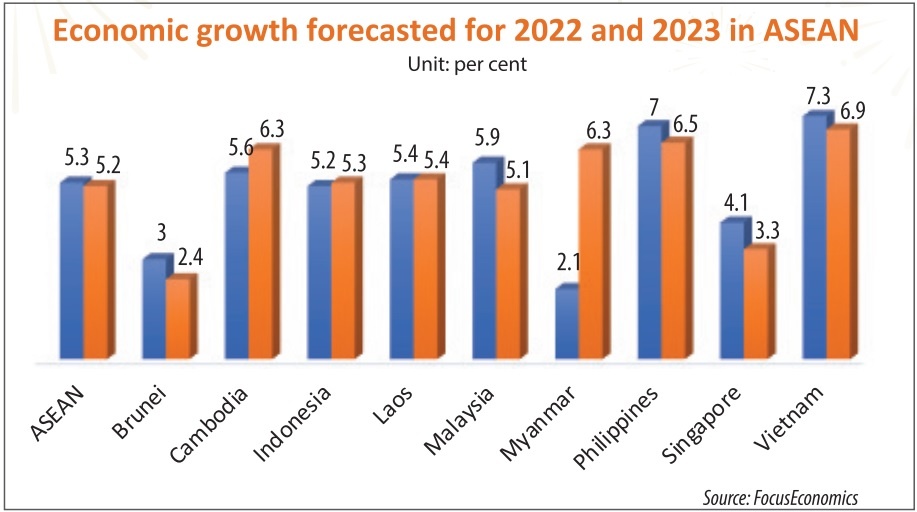INTERNATIONAL INVESTMENT
AND PORTAL

Experts and the government highlighted many encouraging outcomes reaped in the macroeconomic picture in 2021 last week, when they assessed the economic situation for the year.
“Thanks to the government’s flexible policies on controlling COVID-19 and ensuring social security, and the great consensus and solidarity of all units, agencies, and localities, as well as the sharing and support of enterprises and all people from all walks of life, economic activities in Q4 and the whole 2021 have been bouncing back,” said Nguyen Thi Huong, general director of the General Statistics Office (GSO).
According to the GSO, the economy is estimated to grow 5.22 per cent on-year in Q4, higher than the on-year 4.61-per-cent rise in the corresponding period last year.
The growth rate for the whole of 2021 is estimated to be 2.58 per cent – with the rate of 4.72 per cent for Q1, 6.73 per cent for Q2, and -6.02 per cent for Q3 due to serious resurgence of COVID-19, which made heavy dents in all sectors of the economy and forced many key economic hubs in the nation to halt production and business activities.
In 2021, the growth rate was 2.9 per cent for the agro-forestry-fishery sector – responsible for 13.97 per cent of economic growth, 4.05 per cent for the industrial and construction sector – creating 63.8 per cent of economic growth, and 1.22 per cent for the service sector – holding 22.23 per cent of economic growth.
“[Vietnam’s] economic conditions continued to improve. Both industrial production and retail sales registered a third month of growth,” said the World Bank in its December bulletin on Vietnam’s economic situation. “Merchandise exports hit a record high of $34.5 billion in December, helping maintain a third consecutive month of trade surplus while foreign direct investment (FDI) commitment recovered after a brief dip in October.”
Trade bouncing back
Figures from the GSO showed that after six months of consecutive trade deficit, Vietnam’s trade balance returned to a trade surplus, beginning from October. This is quite a positive signal for the economy’s gradual recovery which will help the economy to reach higher growth in 2022, at 6-6.5 per cent as expected by the National Assembly.
In October, the total export-import turnover hit $55 billion, up 2.4 per cent over September, with a trade surplus of $2.74 billion. In November, the figure reached $59.7 billion, with a trade surplus of $100 million, and in December, the respective figures stood at $66.5 billion and $2.54 billion. All these figures are over those in the same period last year.
The export-import turnover for the whole of 2021 hit $668.5 billion, up 22.6 per cent on-year. In which the export and import values totalled $336.25 billion and $332.25 billion, up 19 and 26.5 per cent on-year, respectively. The total trade surplus stood at $4 billion.
The key contributor to the trade surplus in 2021 is foreign-invested enterprises. Their total export-import turnover was $465.72 billion, including $247.54 billion in export turnover (including crude oil exports) – up 21.1 per cent over the same period last year, and $218.18 billion in import turnover – up 29.1 per cent on-year. These companies’ 2021 trade surplus hit $29.36 billion.
According to the GSO, the biggest driver of Vietnam’s export turnover is the shipment of mobile phones and their spare parts, which fetched $57.54 billion, up 12.4 per cent on-year. In Vietnam, Samsung accounts for over 90 per cent of the export turnover of these products. The group has invested over $17.7 billion in Vietnam.
Samsung and many other manufacturers of computers, laptops, and many other electronic products, such as LG, Canon, and Intel, have exported these products with a total turnover of over $51 billion in 2021, up 14.4 per cent as compared to that in 2020.
“The socioeconomic situation in Vietnam has steadily recovered, and witnessed encouraging progress over the past months, as the pandemic is fundamentally under control and the economy is gradually reopened,” stated Prime Minister Pham Minh Chinh. “The confidence of investors and enterprises are also increasing.”
In 2021, total registered FDI hit $31.15 billion, representing an on-year rise of 9.2 per cent, and disbursed capital touched $19.74, down 1.2 per cent on-year.
In Q4, the number of newly established businesses reached more than 31.400 registered at over $18 billion, employing 205,100 new labourers. These are up 70.4 per cent in the number of enterprises, 64.1 per cent in capital, and 24.7 per cent in labourers, all on-year.
“Thus, just two months of implementing the government’s Resolution No.128/NQ-CP dated October 11 on provisional guidelines on safe adaptation to the pandemic, enterprises’ registrations in the remaining months of the year have flourished,” said Huong of the GSO.
“The current hardships are just temporary and the Vietnamese economy, with its solid macroeconomic foundation and stable major balances, is still capable of offering vast potential, advantages, and drivers for future growth,” PM Chinh stressed.
Global analysts FocusEconomics told VIR in a statement that production, especially in industrial and processing activities, has been strongly increasing since October when the government began to ease social distancing.
In 2021, Vietnam’s added value for industrial production increased 4.82 per cent on-year, up from the on-year climb of 3.36 per cent in 2020. In which, that of the manufacturing and processing sector creating 80 per cent of industrial growth climbed 6.37 per cent on-year, higher than the on-year expansion of 5.82 per cent in the same period last year. Electricity production and distribution rose 5.24 per cent on-year, also higher than the on-year ascension of 3.92 per cent in 2020.
“Looking ahead, industrial production is projected to accelerate in 2022 from this year’s estimated level, as the pandemic abates and associated restrictions are eased,” stated FocusEconomics. “Moreover, the underlying strength of Vietnam’s industrial sector remains intact: Vietnam is an attractive low-cost base for manufacturing firms, including those looking to relocate from China due to the US-China trade tensions.”
FocusEconomics estimates that industrial output will grow 9.2 per cent in 2022, and 9.4 per cent in 2023.
Rosy projections
FocusEconomics said, “The economy is estimated to grow at the fastest rate in the region in 2022, following 2021’s projected solid expansion. Higher growth in consumer and capital spending, combined with a robust external sector, should boost activity in 2022. Our panellists expect GDP to expand 7.3 per cent in 2022, and 6.9 per cent in 2023.”
The Asian Development Bank has assumed that if the pandemic is brought under control and full vaccination cover 70 per cent of the population by the second quarter of 2022, the growth forecast for 2022 will be 6.5 per cent.
The World Bank also released its prediction on Vietnam’s economic outlook, saying that the economy could expand by 6.5-7 per cent from 2022 onwards.
This new projection assumes that the current outbreak will gradually be brought under control, allowing the economy to bounce back.
According to the World Bank’s fresh bulletin, the policy of living with COVID-19 will involve continued vigilance and fast action by the authorities, both in vaccination and in social distancing, testing, and quarantining.
“There is also a clear need for fiscal policy support to boost private demand and help the domestic economy recover. Providing financial assistance to impacted workers and households would be an essential avenue to achieve this objective,” said the bulletin.
“Given the available fiscal space, and difficulties registered in implementing the budget in 2021, another policy option for consideration is a reduction in value-added tax for 2022 to support private consumption. Continued close monitoring of the financial sector is also warranted.”



















